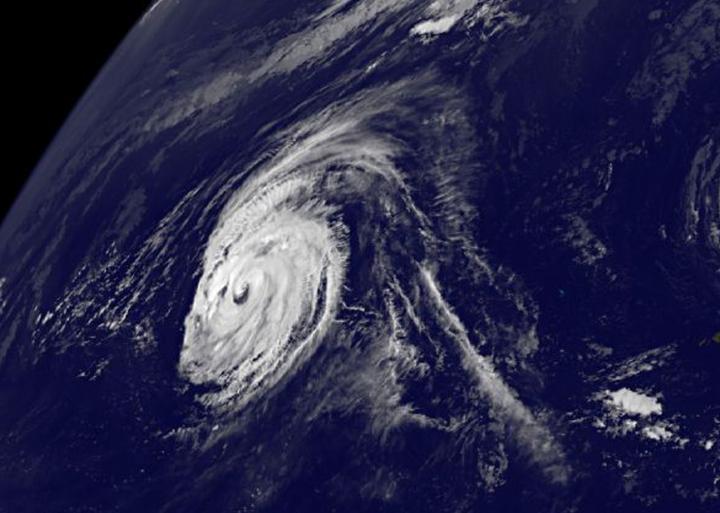Typhoon Kilo moving through northwestern Pacific Ocean

At 11 a.m. EDT on Sept. 2, Typhoon Kilo's eye was visible in a GOES-West satellite image. Credits: NASA/NOAA GOES Project
At 11 a.m. EDT on September 2, Typhoon Kilo's maximum sustained winds were near 90 knots (103.6 mph/166.7 kph).
It was centered near 24.3 North and 179.1 East, about 762 nautical miles east-northeast of Wake Island. Kilo was moving very slowly at 3 knots (3.4 mph/5.5 kph).
At that time, Typhoon Kilo's eye was visible in a satellite image from NOAA's GOES-West satellite. The image also showed powerful bands of thunderstorms wrapping into the low level center of circulation.
GOES-West is managed by NOAA. The image was created by NASA/NOAA's GOES Project at NASA's Goddard Space Flight Center in Greenbelt, Maryland.
Fortunately, Kilo is in open waters and is currently no threat to land areas.
The Joint Typhoon Warning Center expects Kilo to re-strengthen and continue tracking west. It is expected to peak in intensity on September 6.
Media Contact
All latest news from the category: Earth Sciences
Earth Sciences (also referred to as Geosciences), which deals with basic issues surrounding our planet, plays a vital role in the area of energy and raw materials supply.
Earth Sciences comprises subjects such as geology, geography, geological informatics, paleontology, mineralogy, petrography, crystallography, geophysics, geodesy, glaciology, cartography, photogrammetry, meteorology and seismology, early-warning systems, earthquake research and polar research.
Newest articles

High-energy-density aqueous battery based on halogen multi-electron transfer
Traditional non-aqueous lithium-ion batteries have a high energy density, but their safety is compromised due to the flammable organic electrolytes they utilize. Aqueous batteries use water as the solvent for…

First-ever combined heart pump and pig kidney transplant
…gives new hope to patient with terminal illness. Surgeons at NYU Langone Health performed the first-ever combined mechanical heart pump and gene-edited pig kidney transplant surgery in a 54-year-old woman…

Biophysics: Testing how well biomarkers work
LMU researchers have developed a method to determine how reliably target proteins can be labeled using super-resolution fluorescence microscopy. Modern microscopy techniques make it possible to examine the inner workings…





















